Wireless Technology: Antennas, Access Technologies, and Future
VerifiedAdded on 2020/03/02
|5
|1104
|65
Homework Assignment
AI Summary
This assignment delves into the intricacies of wireless technology, examining the diverse categories of antennas based on their performance parameters such as gain, directivity, and frequency. It contrasts CDMA and FDMA technologies, highlighting their operational differences and applications in wireless networking. The paper also explores the future of wireless technology, with a focus on wireless charging as a dominant application, discussing its current advantages and limitations. The assignment provides detailed explanations, comparisons, and a comprehensive overview of the subject matter, supported by relevant references.
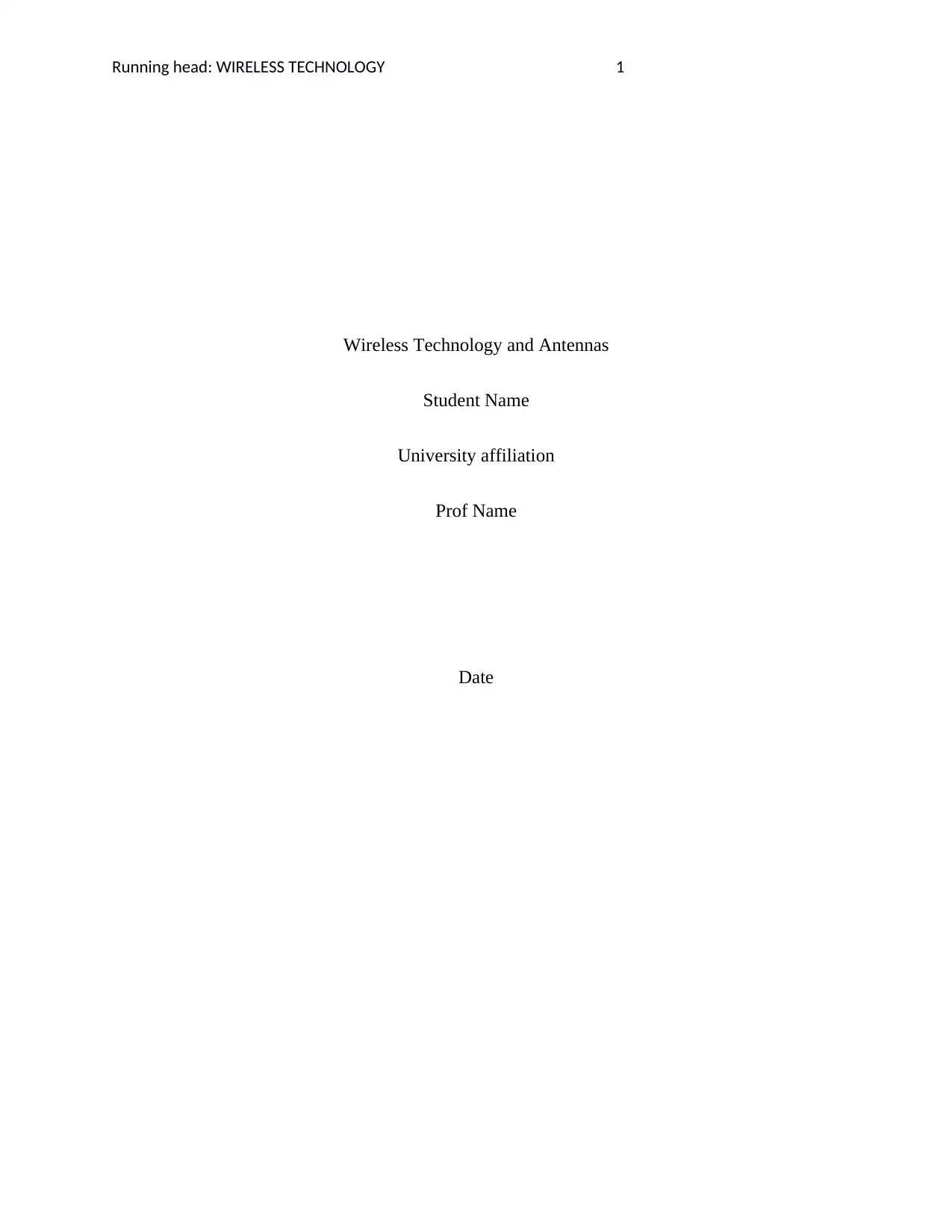
1Running head: WIRELESS TECHNOLOGY
Wireless Technology and Antennas
Student Name
University affiliation
Prof Name
Date
Wireless Technology and Antennas
Student Name
University affiliation
Prof Name
Date
Paraphrase This Document
Need a fresh take? Get an instant paraphrase of this document with our AI Paraphraser
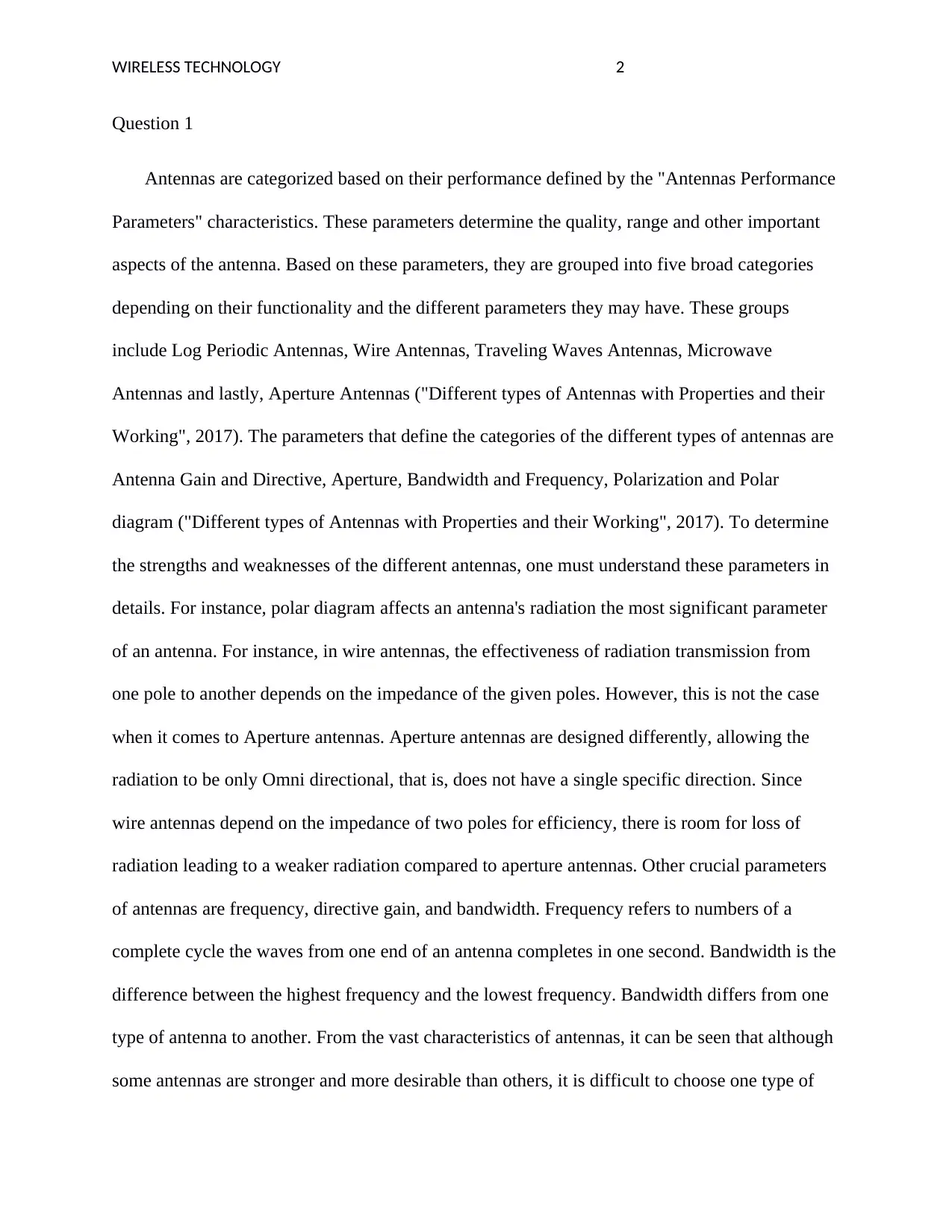
2WIRELESS TECHNOLOGY
Question 1
Antennas are categorized based on their performance defined by the "Antennas Performance
Parameters" characteristics. These parameters determine the quality, range and other important
aspects of the antenna. Based on these parameters, they are grouped into five broad categories
depending on their functionality and the different parameters they may have. These groups
include Log Periodic Antennas, Wire Antennas, Traveling Waves Antennas, Microwave
Antennas and lastly, Aperture Antennas ("Different types of Antennas with Properties and their
Working", 2017). The parameters that define the categories of the different types of antennas are
Antenna Gain and Directive, Aperture, Bandwidth and Frequency, Polarization and Polar
diagram ("Different types of Antennas with Properties and their Working", 2017). To determine
the strengths and weaknesses of the different antennas, one must understand these parameters in
details. For instance, polar diagram affects an antenna's radiation the most significant parameter
of an antenna. For instance, in wire antennas, the effectiveness of radiation transmission from
one pole to another depends on the impedance of the given poles. However, this is not the case
when it comes to Aperture antennas. Aperture antennas are designed differently, allowing the
radiation to be only Omni directional, that is, does not have a single specific direction. Since
wire antennas depend on the impedance of two poles for efficiency, there is room for loss of
radiation leading to a weaker radiation compared to aperture antennas. Other crucial parameters
of antennas are frequency, directive gain, and bandwidth. Frequency refers to numbers of a
complete cycle the waves from one end of an antenna completes in one second. Bandwidth is the
difference between the highest frequency and the lowest frequency. Bandwidth differs from one
type of antenna to another. From the vast characteristics of antennas, it can be seen that although
some antennas are stronger and more desirable than others, it is difficult to choose one type of
Question 1
Antennas are categorized based on their performance defined by the "Antennas Performance
Parameters" characteristics. These parameters determine the quality, range and other important
aspects of the antenna. Based on these parameters, they are grouped into five broad categories
depending on their functionality and the different parameters they may have. These groups
include Log Periodic Antennas, Wire Antennas, Traveling Waves Antennas, Microwave
Antennas and lastly, Aperture Antennas ("Different types of Antennas with Properties and their
Working", 2017). The parameters that define the categories of the different types of antennas are
Antenna Gain and Directive, Aperture, Bandwidth and Frequency, Polarization and Polar
diagram ("Different types of Antennas with Properties and their Working", 2017). To determine
the strengths and weaknesses of the different antennas, one must understand these parameters in
details. For instance, polar diagram affects an antenna's radiation the most significant parameter
of an antenna. For instance, in wire antennas, the effectiveness of radiation transmission from
one pole to another depends on the impedance of the given poles. However, this is not the case
when it comes to Aperture antennas. Aperture antennas are designed differently, allowing the
radiation to be only Omni directional, that is, does not have a single specific direction. Since
wire antennas depend on the impedance of two poles for efficiency, there is room for loss of
radiation leading to a weaker radiation compared to aperture antennas. Other crucial parameters
of antennas are frequency, directive gain, and bandwidth. Frequency refers to numbers of a
complete cycle the waves from one end of an antenna completes in one second. Bandwidth is the
difference between the highest frequency and the lowest frequency. Bandwidth differs from one
type of antenna to another. From the vast characteristics of antennas, it can be seen that although
some antennas are stronger and more desirable than others, it is difficult to choose one type of
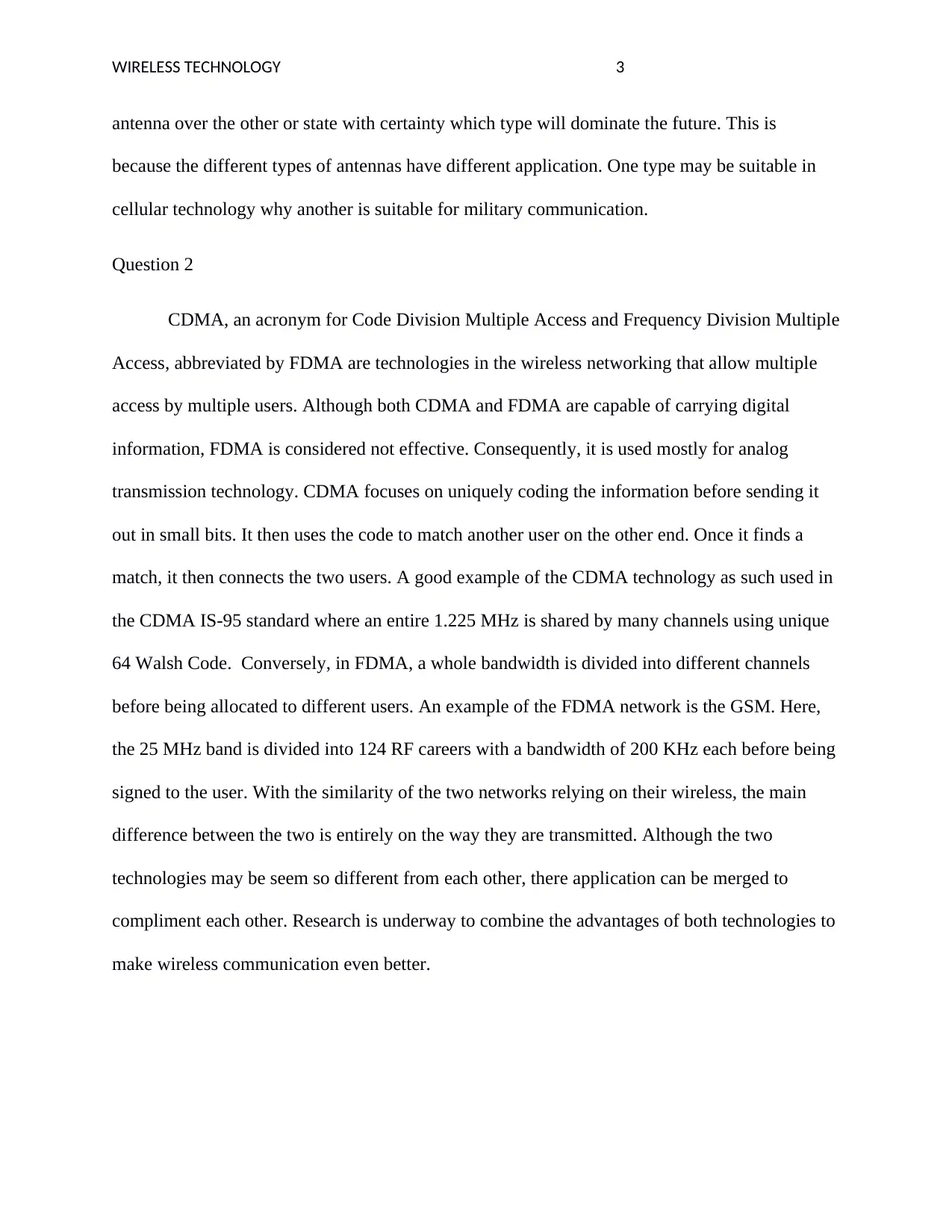
3WIRELESS TECHNOLOGY
antenna over the other or state with certainty which type will dominate the future. This is
because the different types of antennas have different application. One type may be suitable in
cellular technology why another is suitable for military communication.
Question 2
CDMA, an acronym for Code Division Multiple Access and Frequency Division Multiple
Access, abbreviated by FDMA are technologies in the wireless networking that allow multiple
access by multiple users. Although both CDMA and FDMA are capable of carrying digital
information, FDMA is considered not effective. Consequently, it is used mostly for analog
transmission technology. CDMA focuses on uniquely coding the information before sending it
out in small bits. It then uses the code to match another user on the other end. Once it finds a
match, it then connects the two users. A good example of the CDMA technology as such used in
the CDMA IS-95 standard where an entire 1.225 MHz is shared by many channels using unique
64 Walsh Code. Conversely, in FDMA, a whole bandwidth is divided into different channels
before being allocated to different users. An example of the FDMA network is the GSM. Here,
the 25 MHz band is divided into 124 RF careers with a bandwidth of 200 KHz each before being
signed to the user. With the similarity of the two networks relying on their wireless, the main
difference between the two is entirely on the way they are transmitted. Although the two
technologies may be seem so different from each other, there application can be merged to
compliment each other. Research is underway to combine the advantages of both technologies to
make wireless communication even better.
antenna over the other or state with certainty which type will dominate the future. This is
because the different types of antennas have different application. One type may be suitable in
cellular technology why another is suitable for military communication.
Question 2
CDMA, an acronym for Code Division Multiple Access and Frequency Division Multiple
Access, abbreviated by FDMA are technologies in the wireless networking that allow multiple
access by multiple users. Although both CDMA and FDMA are capable of carrying digital
information, FDMA is considered not effective. Consequently, it is used mostly for analog
transmission technology. CDMA focuses on uniquely coding the information before sending it
out in small bits. It then uses the code to match another user on the other end. Once it finds a
match, it then connects the two users. A good example of the CDMA technology as such used in
the CDMA IS-95 standard where an entire 1.225 MHz is shared by many channels using unique
64 Walsh Code. Conversely, in FDMA, a whole bandwidth is divided into different channels
before being allocated to different users. An example of the FDMA network is the GSM. Here,
the 25 MHz band is divided into 124 RF careers with a bandwidth of 200 KHz each before being
signed to the user. With the similarity of the two networks relying on their wireless, the main
difference between the two is entirely on the way they are transmitted. Although the two
technologies may be seem so different from each other, there application can be merged to
compliment each other. Research is underway to combine the advantages of both technologies to
make wireless communication even better.
⊘ This is a preview!⊘
Do you want full access?
Subscribe today to unlock all pages.

Trusted by 1+ million students worldwide
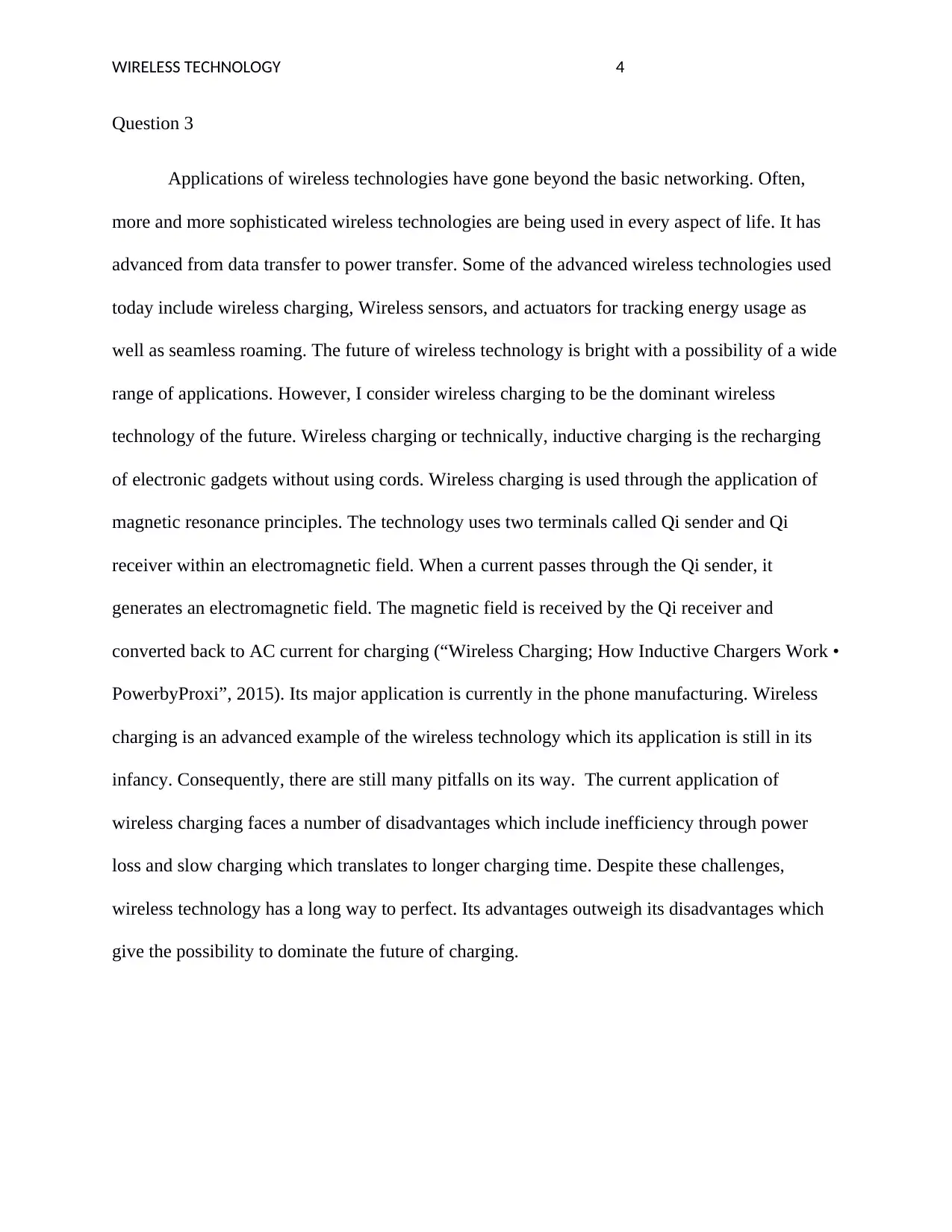
4WIRELESS TECHNOLOGY
Question 3
Applications of wireless technologies have gone beyond the basic networking. Often,
more and more sophisticated wireless technologies are being used in every aspect of life. It has
advanced from data transfer to power transfer. Some of the advanced wireless technologies used
today include wireless charging, Wireless sensors, and actuators for tracking energy usage as
well as seamless roaming. The future of wireless technology is bright with a possibility of a wide
range of applications. However, I consider wireless charging to be the dominant wireless
technology of the future. Wireless charging or technically, inductive charging is the recharging
of electronic gadgets without using cords. Wireless charging is used through the application of
magnetic resonance principles. The technology uses two terminals called Qi sender and Qi
receiver within an electromagnetic field. When a current passes through the Qi sender, it
generates an electromagnetic field. The magnetic field is received by the Qi receiver and
converted back to AC current for charging (“Wireless Charging; How Inductive Chargers Work •
PowerbyProxi”, 2015). Its major application is currently in the phone manufacturing. Wireless
charging is an advanced example of the wireless technology which its application is still in its
infancy. Consequently, there are still many pitfalls on its way. The current application of
wireless charging faces a number of disadvantages which include inefficiency through power
loss and slow charging which translates to longer charging time. Despite these challenges,
wireless technology has a long way to perfect. Its advantages outweigh its disadvantages which
give the possibility to dominate the future of charging.
Question 3
Applications of wireless technologies have gone beyond the basic networking. Often,
more and more sophisticated wireless technologies are being used in every aspect of life. It has
advanced from data transfer to power transfer. Some of the advanced wireless technologies used
today include wireless charging, Wireless sensors, and actuators for tracking energy usage as
well as seamless roaming. The future of wireless technology is bright with a possibility of a wide
range of applications. However, I consider wireless charging to be the dominant wireless
technology of the future. Wireless charging or technically, inductive charging is the recharging
of electronic gadgets without using cords. Wireless charging is used through the application of
magnetic resonance principles. The technology uses two terminals called Qi sender and Qi
receiver within an electromagnetic field. When a current passes through the Qi sender, it
generates an electromagnetic field. The magnetic field is received by the Qi receiver and
converted back to AC current for charging (“Wireless Charging; How Inductive Chargers Work •
PowerbyProxi”, 2015). Its major application is currently in the phone manufacturing. Wireless
charging is an advanced example of the wireless technology which its application is still in its
infancy. Consequently, there are still many pitfalls on its way. The current application of
wireless charging faces a number of disadvantages which include inefficiency through power
loss and slow charging which translates to longer charging time. Despite these challenges,
wireless technology has a long way to perfect. Its advantages outweigh its disadvantages which
give the possibility to dominate the future of charging.
Paraphrase This Document
Need a fresh take? Get an instant paraphrase of this document with our AI Paraphraser
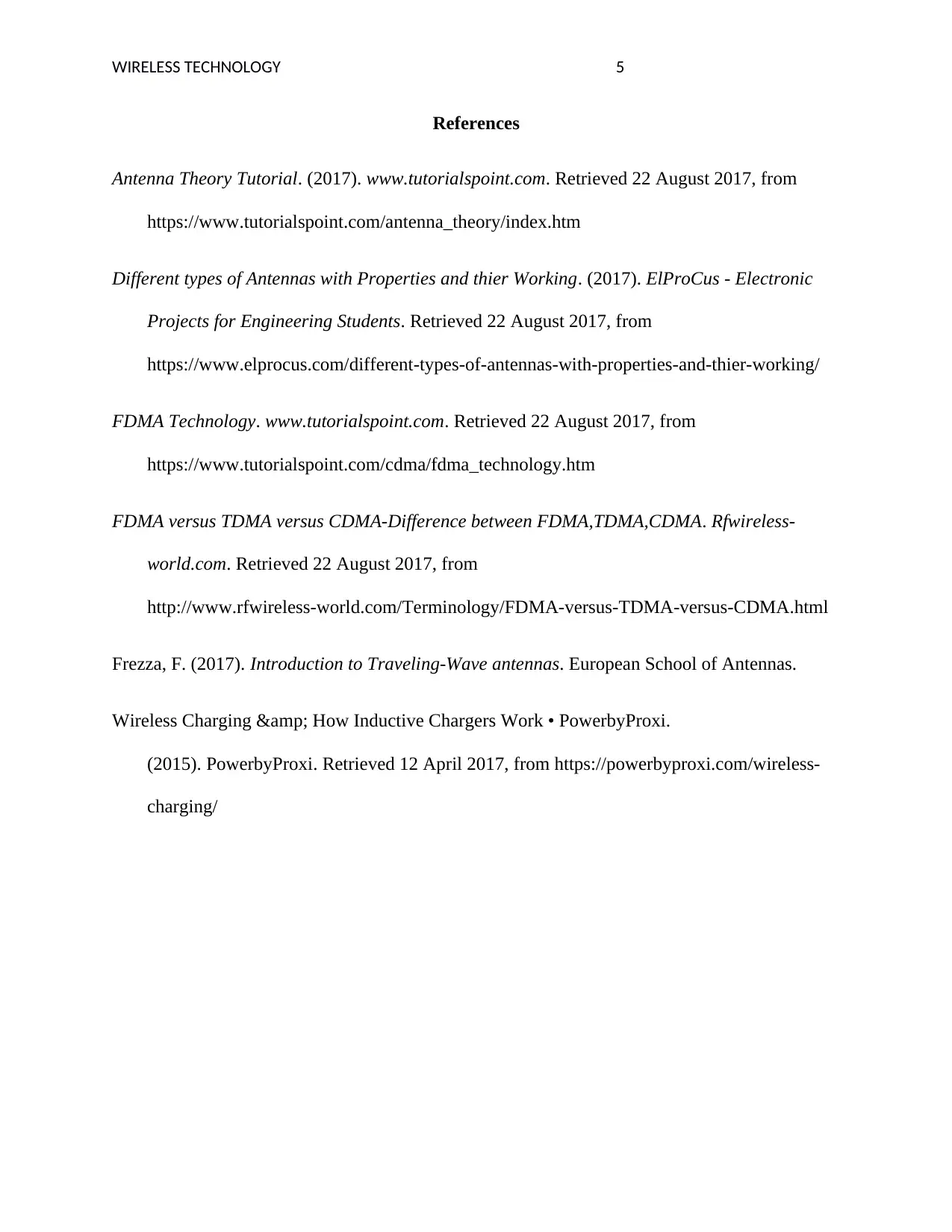
5WIRELESS TECHNOLOGY
References
Antenna Theory Tutorial. (2017). www.tutorialspoint.com. Retrieved 22 August 2017, from
https://www.tutorialspoint.com/antenna_theory/index.htm
Different types of Antennas with Properties and thier Working. (2017). ElProCus - Electronic
Projects for Engineering Students. Retrieved 22 August 2017, from
https://www.elprocus.com/different-types-of-antennas-with-properties-and-thier-working/
FDMA Technology. www.tutorialspoint.com. Retrieved 22 August 2017, from
https://www.tutorialspoint.com/cdma/fdma_technology.htm
FDMA versus TDMA versus CDMA-Difference between FDMA,TDMA,CDMA. Rfwireless-
world.com. Retrieved 22 August 2017, from
http://www.rfwireless-world.com/Terminology/FDMA-versus-TDMA-versus-CDMA.html
Frezza, F. (2017). Introduction to Traveling-Wave antennas. European School of Antennas.
Wireless Charging & How Inductive Chargers Work • PowerbyProxi.
(2015). PowerbyProxi. Retrieved 12 April 2017, from https://powerbyproxi.com/wireless-
charging/
References
Antenna Theory Tutorial. (2017). www.tutorialspoint.com. Retrieved 22 August 2017, from
https://www.tutorialspoint.com/antenna_theory/index.htm
Different types of Antennas with Properties and thier Working. (2017). ElProCus - Electronic
Projects for Engineering Students. Retrieved 22 August 2017, from
https://www.elprocus.com/different-types-of-antennas-with-properties-and-thier-working/
FDMA Technology. www.tutorialspoint.com. Retrieved 22 August 2017, from
https://www.tutorialspoint.com/cdma/fdma_technology.htm
FDMA versus TDMA versus CDMA-Difference between FDMA,TDMA,CDMA. Rfwireless-
world.com. Retrieved 22 August 2017, from
http://www.rfwireless-world.com/Terminology/FDMA-versus-TDMA-versus-CDMA.html
Frezza, F. (2017). Introduction to Traveling-Wave antennas. European School of Antennas.
Wireless Charging & How Inductive Chargers Work • PowerbyProxi.
(2015). PowerbyProxi. Retrieved 12 April 2017, from https://powerbyproxi.com/wireless-
charging/
1 out of 5
Related Documents
Your All-in-One AI-Powered Toolkit for Academic Success.
+13062052269
info@desklib.com
Available 24*7 on WhatsApp / Email
![[object Object]](/_next/static/media/star-bottom.7253800d.svg)
Unlock your academic potential
Copyright © 2020–2025 A2Z Services. All Rights Reserved. Developed and managed by ZUCOL.





